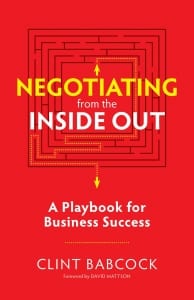The Most Common Negotiating Gambit… and How to Beat It

The group I was in front of came from all types of industries. Some sold technology and professional services, which means they often have to deal with professional buyers and procurement teams; others were in commercial real estate and finance, which means they typically have to deal with senior executives when it comes to negotiations; and some sold to individual consumers. So it was a very diverse group. The responses, however, were strikingly similar in tone. Here are the most common responses they wrote down:
- Your competition is cheaper.
- What can you do for us?
- You’re going to need to sharpen your pencil.
- Please send us a revised proposal, as your price is too high.
- What kind of discounts or promotions do you have?
All of these are expressions of the exact same gambit. My guess is that you personally have used some variation or one or more of the sentences you just read, which means you, too, have used this very same gambit – the gambit I call “Your Competition Is Cheaper.” It’s natural to want to get the best possible deal. Why wouldn’t you ask and see what happens?
I then requested that the members of the group write down the way they typically respond to such a request. Here’s a small sampling of what they wrote:
- Well, let me see what I can do…maybe I can take something off my proposal.
- Let me talk to my manager.
- Where do we need to be to get the deal?
- I’m sure we can do something, what were you hoping for?
These are not the responses you will hear from a professional negotiator.
What those salespeople wrote down immediately told me that they didn’t have a system or plan for negotiation. They had never practiced how to handle this gambit. In all of their responses, they immediately gave in to the buyer’s demand. This was no surprise. In my experience, if you ask a salesperson if they have a negotiation system, the answer is almost always “no”!
Most organizations face some kind of negotiating gambit during a sales process, and “Your Competition Is Cheaper” is one of the most popular. My job is to train people in an effective negotiating system so they can deal with such gambits. Our Sandler Negotiating Playbook provides such a system. It consists of three steps. They aren’t difficult to understand, but they do take time and practice to reach a point where you can utilize them under pressure.
Step One: Acknowledge, Reassure, Ask. Our primary goal here is to find the right way to say “No, we are not giving you anything” – without saying the word “no.” What we are doing is acknowledging that they asked for something, reassuring them that our solution will take care of their issues, and asking them a question to get them talking and put the focus back on them.
Step Two: Struggle and Redirect. In some situations, we’re going to need this step to ensure we don’t just give in to their demands. The second step is designed to show them that we are emotionally struggling with their ask, and that we feel uncomfortable. The redirect is a move designed to take them back to why they are even looking to solve the problem … and to find out if they even like our solution. (They may not.)
Step Three: Concessions. The main focus with the concessions step is to ensure that we have already thought about what we are willing to concede and what we want to get in return. When we do offer a concession, we’ll want to give slowly and struggle – and we’ll want to secure a parallel concession from the other side. There is an art to granting concessions. This art requires us to modify our offer in order to get something of greater or equal value to what we are giving up – which might be a signed order.
Remember, it’s always better to add something into the deal that has value instead of taking something away. This is especially true when it comes to price!
About the Author

For more information, please visit https://www.sandler.com/resources/sandler-books/negotiating-from-the-inside-out/.






